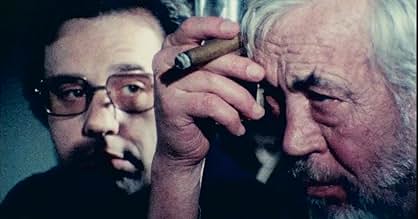Agrega una trama en tu idiomaIn the final fifteen years of the life of legendary director Orson Welles, he pins his Hollywood comeback hopes on a film, The Other Side of the Wind (2018), in itself a film about an aging ... Leer todoIn the final fifteen years of the life of legendary director Orson Welles, he pins his Hollywood comeback hopes on a film, The Other Side of the Wind (2018), in itself a film about an aging film director trying to finish his last great movie.In the final fifteen years of the life of legendary director Orson Welles, he pins his Hollywood comeback hopes on a film, The Other Side of the Wind (2018), in itself a film about an aging film director trying to finish his last great movie.
- Premios
- 2 premios ganados y 2 nominaciones en total
- Self - Director
- (material de archivo)
- …
- Self - Camera Operator
- (as Mike Ferris)
- Self - Editor
- (as Jonathan Braun)
Argumento
¿Sabías que…?
- ErroresA clip from "It's All True" labels the film as "Unreleased." In fact, it was completed and distributed by Paramount in 1993.
- Citas
Peter Jason: Orson said to me once that, "Los Angeles is the only city where every roads leads to the airport. If you're here, Hollywood can't wait to get you out of here''.
- ConexionesFeatures Alicia en el país de las hadas (1933)
- Bandas sonorasHeart of the Sunrise
Written by Jon Anderson, Chris Squire, Bill Bruford and Rick Wakeman
Performed by Yes
Courtesy of Atlantic Recording Corp.
By arrangement with Warner Music Group Film & TV Licensing
Orson Welles, as most people know, could not get financing for his movies later on in his life. Why? The reason is because film studios have become corporate machines, making money rather than making art. Since the days of Star Wars and Jaws, film studios have been much more concerned with the idea of box office receipts than with the idea of presenting filmmakers as artisans. These days, news papers are obsessed with the box office of a film even more than the plot.
Welles, in his later years, was against all the paper pushers and money launderers that populate the film industry. Unfortunately, he also had to pander to them to get funding. So he went into a depression and made some terrible choices, relegating himself into a characterture of his former self, appearing in ridiculous films, TV commercials, and started on a downhill slide that culminated in making some absolute disasters in order to try to accumulate any kind of investments.
At one point, he attempted to communicate this in a film called "The Other Side of the Wind" in which the main character, a Director, coming to terms with his 70th birthday, is confronted by a younger version of himself in the form of another Boy Wonder who makes commercial films which are successful money makers. The two characters are played by the legendary John Huston as the older man and Peter Bogdanovich as the Wunderkind. At the time the film was being shot, Huston was most like the real character of Welles himself, and Bogdanovich was a hybrid of all the successful Lucases and Spielbergs of the world.
In addition, the story of "Wind" also includes a playful 70's type of Avant Guarde film, one that would easily have fit in with the "Easy Rider" and "Zabriskie Point" genre of films which represented the alternative film industry. The story then zigzags back and forth between the "real" story of the Director and the "fantasy" story of the trippy film, with Welles' Muse, the gorgeous Oja Kodar as the lead girl, traipsing thru endless psychedelic environments, followed by a mute boy, and culminating in a fantasy sex scene while being driven by another actor in a car in a rainstorm-- a scene as erotic as possible in the era of free love and experimentation.
However, the documentary is more complex, and captures the essence of Welles' philosophy of life in which he is constantly at odds with the business of filmmaking throughout his entire life.
The saddest part of the story is when Welles, who was dependent on Peter Bogdanovich at one point, betrays his friend by saying negative things about him on a talk show. One wonders what was his motive in doing so -- was Welles being subconsciously self-destructive? Was he jealous of Peter's ability to make financially successful films? There is even a part in the shooting of "Wind" where he casts a 19-year-old girl as the pawn between the two Directors, and one is immediately reminded of Bogdanovich's obsession with Cybil Sheppard, who was also 19 when she was cast as the actress in "Last Picture Show."
In fact, so much of "Wind" is a reflection of Welles' life, that it is almost another attempt at telling the story of "8 1/2", which captures Fellini's trials and tribulations while making a film that also would never be released. Welles is subconsciously telling us the story of his life, all the while denying that this was his intention.
- nick94965
- 29 oct 2018
- Enlace permanente
Selecciones populares
- How long is They'll Love Me When I'm Dead?Con tecnología de Alexa
Detalles
- Tiempo de ejecución1 hora 38 minutos
- Color
Contribuir a esta página

































